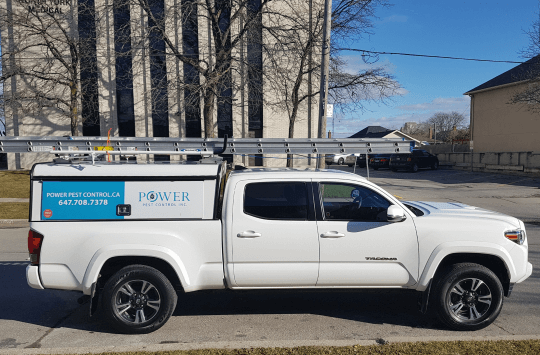Professional Wasp Nest Removal Services
Call us at 647-708-7378
Request A Free Quote
Wasp Nest Removal
Wasps are one of the most unwanted pests that can disrupt your family and home. In Southern Ontario, bald-faced hornets and yellow jackets are two wasp species that typically display aggressive behavior, meaning they’ll attack your family and pets on instinct.
Unlike bees that feed off pollen and are vital for the survival of many crops, plants, and flowers, wasps feed off other insects and common foods found around your home and yard.
Yellow jackets can feed off fruit, sugary drinks, and insects, thereby making them a pest that will be constantly attracted to common items around your home, especially where human activity is frequent.
Power Pest Control is your wasp removal expert in Toronto. We will find the nest and eliminate it using the safest methods to protect you and your loved ones.
With years of experience serving our clients across the Greater Toronto Area, there isn’t a wasp problem we can’t control!
Signs of a Wasp Nest
A wasp nest should be handled quickly to prevent it from growing and to prevent anyone from getting stung. If you are seeing a large number of wasps or hornets in your yard, there is a good chance that there is a nest nearby. Just one mature nest can be home to thousands of wasps, so it is important to find the source of the problem. In order to identify the nest, it helps to know a little about the kind of nest each type of wasp builds so you know what to look for based on the type of wasps you see flying around.
SUCCESS STORIES
Our Wasp Nest Removal Process
When it comes to wasp nest removal in Toronto, you need to have experience to ensure you properly remove the nest and eradicate the problem. Over the years, our experts have worked to perfect our process to create the safest extraction process both for us and for you as the homeowner. We strive to use the least amount of toxic chemicals as possible so that the extraction will cause no harm to your children or pets.
Here is a breakdown of our wasp nest removal process:
Step 1. We will first get a better understanding of your pest problem by providing a free no obligation quote over the phone so that you have a general understanding our pest elimination process and cost.
Step 2. The wasp control process begins with an inspection from our wasp extermination team. They will locate the nest and create a plan to use the least toxic insecticides to that will be safe around your children and pets.
Step 3. Our wasp exterminators will begin work and once the wasp nest has been treated, we will engage in the process of wasp nest removal and disposal if the nest is readily accessible.
Step 4. As a valued added service, we will look for additional wasp nests on your property at no extra charge and remove the additional nests for a small fee.
Problems with a Wasp Infestation in Your Home
First and foremost, the main concern of a wasp nest on your property is that someone will be stung by these pests. Not only do the stings hurt a lot, but many people are allergic and one sting can result in a severe reaction.
With an entire nest, there is also the risks of swarms. A sting from one wasp is bad enough, but if a person disrupts and entire nest, a serious stinging episode may occur, which can be extremely dangerous even to people who are not allergic to the stings.
Not only does a wasp infestation impose a safety hazard on your property, but it can also cause serious damage to your house’s structure, particularly if the nest is inside of the home. The burrowing tendencies of some of these pests can expand crevices and cause damage to the wallboards or ceiling.
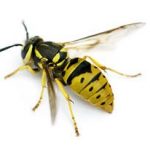
Yellow Jackets – A yellow jacket nest can be identified by a papery covering. They are typically found within the inside of voids in walls, in trees, or in holes in the ground. They are very social insects, each with a duty to protect the queen at all costs.
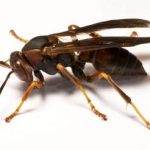
Paper Wasps – These nests can typically be see in plain sight. Paper wasps build exposed nests, and some even build on top of an old nest. The nest has an upside-down umbrella appearance, and can get pretty large if not managed.

Hornets – These nests can usually be found in natural cavities such as tree stumps. The nest is covered in a papery shell.
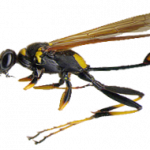
Mud Daubers – True to their name, mud daubers create nests out of clay and mud. The nests are typically built in existing cracks or cavities.
Wasp Control Experts & Wasp Nest Removal in Toronto
Common DIY Methods (and Why They are Ineffective)
1. Burning the Nest
Using fire to remove anything is never a sound idea. Wasp nests should never be removed using fire.
They are made from paper substances that worker wasps create by chewing on wood and making it into pulp. This is highly flammable and burning one poses the threat of igniting your entire house; not just the nest.
Also, fires are not the most efficient form of pest control in Toronto. The wasps are not killed with fire; instead, you’ll have just aggravated them, and they will most likely turn violent on you.
The remaining wasps in the nest will look for food and attack bystanders, your loved ones, and even neighbors as they do so.
Lastly, they will rebuild their nest somewhere else on your property.
2. Spraying with Water
Water removal methods are often recommended online, but this is not a safe way to remove wasps.
Flooding wasps will most likely cause water damage to your home, especially if they are nesting in your eaves. Also, flooding a nest could force you to flood your attic or basement.
Lastly, flooding the nest will not get rid of all the wasps; and just like fires, they will become aggravated and attack.
3. Swatting or Beating the Nest
Yes, some people do attempt to beat down wasp nests. This is by far the worst way to try to remove a wasp nest in your home.
You are putting yourself and anyone around you at risk for a sting or swarm. If you are allergic to wasp venom, then you could be risking your life doing this.
Why Call a Professional Bee Nest Exterminator?
No matter how large the wasp nest grows, Power Pest Control can handle the problem. Wasp nests start small in the spring, about the size of a golf ball. At this stage, they can become very aggressive as the size of the nest grows to the size of a basketball.
Once it reaches this size, “doing it yourself” is not option. This is one of many reasons it is important to contact a wasp nest removal specialist before you or your loved ones get hurt. An expert is trained for the task, and equipped with the tools to do the job efficiently.
[vc_video link=”https://www.youtube.com/watch?v=DeRS5CMJUk4″]
Why Should You Hire a Trained Expert?
1. They Have the Right Equipment
A professional wears safety equipment that protects them from swarms and stings.
They have respiratory protective equipment as well so that they are completely protected from the harm of removing the nest. This material is only available to professionals, and it is costly for homeowners to purchase.
2. Technicians Can Remove Pests in Tight Places
Wasps could nest in your attic or other small spaces. A technician is trained to get into these areas and remove wasp’s nests safely.
3. A Professional Has Expert Knowledge when it Comes to Wasps
Pest control experts in Toronto know wasps, understand how they react, and know how to eradicate them.
They know their instincts and behavior, and they can even identify areas where other nests are forming and remove them.
4. Exterminators Have Products Specific to Wasp Eradication
The entire point of removing the nest is to kill off the colony and keep wasps from coming back. Most of the products you purchase at your local hardware store are not effective in long-term control.
A pest control professional has access to control products that work on wasps, but also keep them from coming back for six months to a year.
Inspection
Our wasp control process will begin with an inspection of the nest you have found, as well as the rest of the property to ensure there are no more nests that you are missing. If we were to find another nest we would treat that one as well, no extra charge to you. If you are unsure of the location of the nest, we will expertly find the nest before moving on to treatment.
Treatment
Once all of the nests have been detected, we will begin treatment with the least toxic insecticides we have. This product is safe to use around children and pets. The exterminators will then begin to extract the nest if it is easily accessible. Once the nest is removed, we go about proper means of disposing of it in a safe manner.
No matter how large the wasp nest grows, Power Pest Control can handle the problem. Wasp nests start small in the spring, about the size of a golf ball then they tend to grow to the aggressive basketball-sized nests that could pose severe hazard for anyone at or near the home. Whether your nest is still small or whether it has grown to be far larger and way past the point that DIY methods may work, we will handle the nest and the inhabitants, ensuring that there is nothing left for the pests to return to.
We are your wasp nest removal experts in Toronto and our team of wasp exterminators have seen it all.
Don’t let wasps bother you! Contact the wasp exterminators in Toronto with years of experience! We are a top-rated company on HomeStars. Our blog has many more valuable resources for homeowners, check it out here.
Follow Up- How to Stop Wasps from Returning
Once you finally rid your property of the pests, the last thing you want is for them to return. There are multiple steps you can take in the areas they once inhabited to prevent them from returning.
- Spray insecticide in any of the house’s crevices. This should be applied every spring and fall.
- Place wasp traps around your home.
About Wasps
Wasps are fairly distinctive. They are normally about 15 mm, or 0.6 inches in length, generally with a brown or black color banded by thin yellow stripes.
Types of Wasps

Bald-Faced Hornets – These wasps are usually black with a little bit of white and yellow. These wasps are considered social insects, meaning they tend to stick in a pack to defend the nest.

Yellow Jackets – These wasps look a lot like bald-face hornets, but with a much bolder yellow color paired with the black. They are also considered to be social insects and they tend to support each other in both the building and defending of the nest.
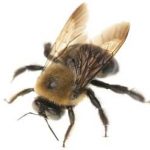
Carpenter Bees – These bugs are typically rounder than the others, and have a furry appearance. They typically appear with yellow and black stripes. The males are harmless to people, as they do not have a stinger, however the females do, so it is not wise to risk an interaction with these insects.
Wasp Behavior
Luckily, wasps are often easier to deal with than other pests. Known for their ability to make large and complex nests, they prefer to use paper as a construction material. These bowl-shaped homes can be upside down and have only a single layer. Unlike other pests, each nest may only be home to a dozen or fewer wasps.
You may notice a wasp’s nest by its distinctive stalk, which they use to suspend their home from eaves or gutters of buildings. They may also be suspended from branches of trees.
Wasps are not generally aggressive, but they are capable of defending their nest if disturbed and will sting invaders. Some wasps will telegraph their attack before stinging, by vibrating and raising their front legs. This is a good warning sign that these are aggressive wasps, and should be avoided.
Wasp Vs. Bees
Though wasps and bees are similar in nature, there are a few key distinctions between the two. For starters, a wasp is much more aggressive than a bee. While bees will typically only sting as self-defense, wasps can be provoked to sting. A main reason for this is bees die after they sting someone, making it a last resort, however wasps are able to sting multiple targets.
The two differ greatly in their feeding habits as well. Bees feed off of flowers as pollinators, and wasps act as predators.
Finally, the two insects have distinguishably different habitats. Bees tend to build and in geometric wax hives. Wasp nests, on the other hand, tend to be papery in appearance.
Breeding Habits
In the world of wasps, the males are somewhat expendable. Over the winter, if a female has mated, she will live in the nest. The males and any females who have not mated will die.
Once spring comes, the surviving females will fight for control. The strongest wasp will become the dominant one and the rest will lay their eggs. These will hatch into new wasps who will mate with each other. The dominant female may then die and the wasps may move to a new nest.
What Wasps Eat and Where They Live
Wasps will eat a wide variety of food, including fruit and the larvae of other insects.
A wasp nest is its home, and many of these nests survive through the winter. Although the male workers and unfertilized females die in the cold, the dominant queen wasp will hibernate inside her nest. Once spring begins, the queen will then begin the construction of a new home.
These nests are made from materials that the wasps find. They often use a combination of chewed up wood and their own saliva. Check for holes in your building or property, as well as more distant locations like wells or outhouses. The nest might be hard to spot because it might be recessed.
What to Do if you Have a Wasp Infestation
Because wasps can, and do, sting humans, it is best to leave a wasp problem in the hands of professionals.
At Power Pest Control, our team of professional exterminators are experts at identifying wasp nests and removing the threat. Our team will find the location of the nest, and remove it safely. Because the average Toronto homeowner may not know the signs of a wasp infestation, they can struggle with dealing with the nest for good.
Contact us today for a consultation and let us handle any of your wasp problems effectively from start to finish.
AREAS WE SERVICE
Power Pest Control has been a quality provider of the best pest control and extermination service since our establishment. It is with great pride and joy we announce that we serve our customers in Toronto and all neighboring areas. We want you to be able to reach us wherever you are promptly and conveniently. Choose your location and click below for additional information.
YOUR PEACE OF MIND COMPANY… CALL US 647-708-7378

